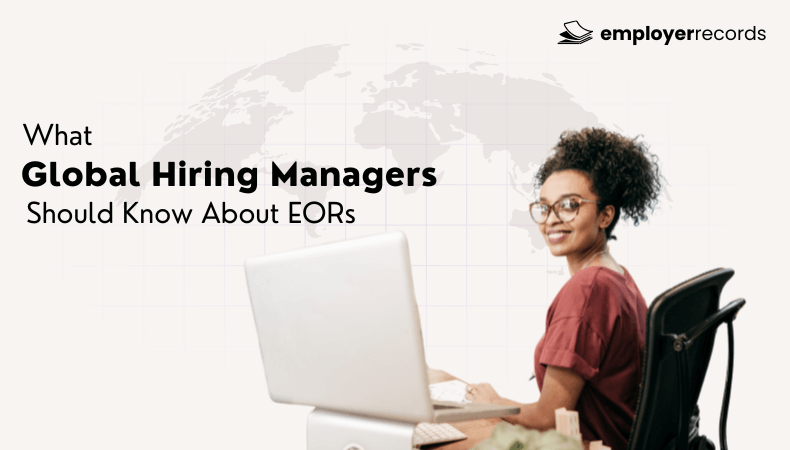Hiring someone in another country might sound simple, send an offer, ship a laptop, and get them started. But behind the scenes, it’s a maze of local labor laws, tax rules, and paperwork.
For many companies, especially those hiring remotely for the first time, these complexities can slow down onboarding or cause compliance issues they didn’t expect.
That’s where Employer of Record (EOR) services come in. Instead of setting up a local entity or figuring out every country’s regulations yourself, you partner with an EOR that handles all the legal and administrative work.
From employment contracts to payroll and taxes, the EOR acts as the official employer, so your new hire can get started without delays and without legal headaches.
In this guide, we’ll walk you through how to onboard remote employees using an EOR, why it’s often the simplest route for global hiring, and how to make sure your onboarding process feels smooth and welcoming from day one.
Key Takeaways
- An Employer of Record (EOR) allows companies to hire and onboard remote employees globally without setting up local entities.
- EORs handle critical HR tasks like payroll processing, tax compliance, benefits administration, and employment contracts, ensuring full local compliance.
- Onboarding through an EOR speeds up hiring, reduces costs, and minimizes compliance risks when expanding internationally.
- The EOR-managed onboarding process includes steps like needs assessment, documentation, equipment setup, orientation, and ongoing support.
- Implementing best practices, such as structured onboarding schedules, personalized welcome kits, and cultural sensitivity, ensures a smooth experience for remote hires.
What Is An Employer Of Record (EOR)?
In case you’re new to the term, an Employer of Record (EOR) is a service provider that acts as the official employer of your international hires, handling local compliance, payroll, benefits, and taxes on your behalf. If you’d like a deeper dive, check out our full guide: What is an Employer of Record?
Below is a list of the key roles EORs play:
- Payroll processing
- Tax compliance
- Benefits administration
- Employment contracts
- Onboarding and offboarding procedures
By partnering with an EOR, companies can hire remote employees in different countries without the need to establish a local entity, ensuring compliance with local labor laws and regulations.
Payroll Processing
Payroll processing involves calculating employee earnings, withholding deductions, and issuing paychecks on a regular schedule in full compliance with local laws.
The EOR runs these payroll cycles end-to-end, collecting timesheets, computing gross-to-net wages, and applying statutory deductions like social security and garnishments.
It also generates payslips and annual tax statements for employees.
Tax Compliance
Tax compliance encompasses withholding, reporting, and remitting payroll taxes, income tax, social contributions, and other levies, to authorities.
The EOR stays current with evolving tax regulations, handles quarterly and annual filings, and ensures all statutory payments are made on time to avoid penalties. It also manages tax registrations and local tax IDs for new hires.
Benefits Administration
Benefits administration covers designing, enrolling, and managing employee benefit plans—health insurance, retirement schemes, paid leave, and statutory benefits, tailored to local mandates.
The EOR negotiates with insurers, processes enrollments, and administers claims, ensuring compliance with regional labor laws and plan regulations. It also maintains records, communicates benefits changes, and handles renewals or terminations.
Employment Contracts
Employment contracts define the legal relationship between employer and employee, outlining job scope, compensation, benefits, and compliance with labor laws.
The EOR drafts, reviews, and executes these contracts, often requiring dual or parallel agreements to satisfy both client company policies and host-country regulations.
It also maintains updated documentation and manages amendments throughout the employment lifecycle.
Onboarding and Offboarding Procedures
Onboarding and offboarding procedures ensure smooth entry and exit experiences: onboarding covers orientation, IT provisioning, policy training, and cultural integration.
Offboarding addresses exit interviews, asset retrieval, final payroll calculations, and compliance with notice-period laws.
The EOR orchestrates both processes, handling all legal paperwork, system access setup/removal, and local compliance checks to protect employer and employee alike.
Key Benefits of Onboarding Remote Employees via an EOR
Onboarding remote employees across international borders presents a myriad of challenges, from navigating complex local labor laws to managing diverse payroll systems and benefits structures.
These complexities can lead to significant delays, increased costs, and potential compliance risks for businesses aiming to expand their global footprint. Partnering with an Employer of Record (EOR) offers a strategic solution to these challenges.
An EOR assumes the legal responsibilities of employment, including payroll processing, tax compliance, benefits administration, and adherence to local labor regulations, thereby enabling companies to onboard remote employees efficiently and compliantly without the need to establish a local entity.
The following sections delve into the key benefits of onboarding through an EOR, highlighting how this partnership can streamline operations, mitigate risks, and facilitate seamless integration of remote employees into your organization.
- Global Compliance: EORs possess in-depth knowledge of local employment laws, ensuring that all hiring practices adhere to regional regulations.
- Faster Onboarding: With established processes and infrastructure, EORs can expedite the onboarding process, allowing new hires to start promptly.
- Cost Efficiency: Avoiding the setup of local entities reduces administrative and legal costs associated with international hiring.
- Risk Mitigation: EORs assume the legal responsibilities of employment, minimizing risks related to misclassification and non-compliance.
- Focus on Core Business: Outsourcing HR functions to an EOR allows companies to concentrate on strategic initiatives and growth.
EOR-Based Onboarding vs. In-House Global Hiring
| Aspect | EOR-Based Onboarding | In-House Entity Setup |
|---|---|---|
| Time to Onboard | 1–3 weeks | 3–6 months (entity setup + hiring process) |
| Legal Compliance | Handled by EOR | Handled internally with local legal support |
| Cost | Service fee only (no setup costs) | High setup, ongoing operational costs |
| Payroll & Tax Management | Managed by EOR | Managed internally |
| Risk of Misclassification | Minimal (EOR assumes responsibility) | High (requires legal oversight) |
| HR Administration Burden | Low (outsourced) | High (fully internal) |
| Employee Experience | Fast, streamlined onboarding | Often delayed due to admin complexities |
How to Onboard Remote Employees Using an Employer of Record (Step-by-Step Guide)
Onboarding remote employees through an Employer of Record (EOR) is a strategic approach that streamlines the complexities of international hiring.
By leveraging an EOR, companies can ensure compliance with local labor laws, manage payroll and benefits efficiently, and provide a seamless onboarding experience for their remote workforce.
This step-by-step guide outlines the essential phases of onboarding remote employees via an EOR, offering insights into best practices and considerations to facilitate a smooth integration process.
Step.1. Initial Consultation And Needs Assessment
The onboarding journey begins with a comprehensive consultation between your company and the EOR provider. This discussion focuses on your hiring objectives, target countries, and specific requirements.
By aligning expectations and clarifying the scope of services, the EOR can tailor its approach to meet your organization’s unique needs, ensuring a smooth and compliant hiring process.
Step.2. Documentation And Compliance
The EOR manages all necessary documentation, including drafting and signing employment contracts, collecting employee information and identification, and ensuring adherence to local labor laws and tax regulations.
This meticulous process guarantees that all legal requirements are satisfied before the employee’s start date, mitigating risks and ensuring compliance across different jurisdictions.
Step.3. Provision Of Equipment And Access
Coordinating with the EOR ensures that new hires receive essential tools and access, such as company hardware (laptops, monitors), internal systems, and communication platforms.
Providing these resources from day one fosters productivity and engagement, enabling employees to integrate seamlessly into their roles and the organization’s workflow.
4. Orientation And Integration
A comprehensive orientation program introduces new employees to the company’s culture, values, organizational structure, and key contacts. Training on company policies and procedures is also provided.
Facilitating team introductions through virtual meetings helps foster connections and collaboration, ensuring that remote employees feel welcomed and integrated into the team.
5. Ongoing Support And Feedback
Maintaining regular check-ins with new employees allows for addressing concerns and providing constructive feedback. Utilizing performance metrics and Key Performance Indicators (KPIs) helps monitor progress and ensure alignment with company goals.
This continuous support fosters employee development and contributes to long-term success within the organization.
Best Practices for Remote Employee Onboarding with an EOR
Successfully onboarding remote employees requires a deliberate and structured approach to ensure they feel connected, informed, and supported from day one.
Implementing best practices can bridge the physical distance, fostering engagement and productivity in a virtual work environment.
- Personalized Welcome Packages: Sending personalized welcome packages that include branded merchandise or handwritten notes can make new hires feel valued and connected to the company culture. These thoughtful gestures help establish a positive first impression and foster a sense of belonging from the outset.
- Structured Onboarding Schedule: Implementing a structured onboarding schedule provides new employees with a clear roadmap of training sessions, meetings, and key milestones. This organized approach helps reduce uncertainty, accelerates learning, and enhances overall productivity.
- Accessible Resources: Providing easily accessible resources such as company handbooks, FAQs, and support channels ensures that new hires can navigate their roles effectively. This accessibility promotes inclusivity and empowers employees to seek information and assistance as needed.
- Cultural Sensitivity: Being mindful of cultural differences and time zones when scheduling meetings and assigning tasks demonstrates respect and inclusivity. This awareness fosters a collaborative environment and enhances communication among diverse teams.
- Feedback Mechanisms: Implementing regular feedback mechanisms, such as surveys or feedback sessions, allows organizations to gather insights into the onboarding experience. This continuous feedback loop facilitates improvements and ensures that the onboarding process remains effective and responsive to employee needs.
Conclusion
Onboarding remote employees through an Employer of Record (EOR) offers a strategic advantage for companies aiming to expand their global workforce efficiently.
Partnering with an EOR, businesses can navigate the complexities of international hiring without the need to establish local entities, ensuring compliance with diverse labor laws and regulations.
This collaboration allows for streamlined administrative processes, including payroll, benefits administration, and tax compliance, freeing internal resources to focus on core business objectives.
Moreover, EORs expedite the onboarding process, enabling new hires to commence work promptly, which is crucial in competitive talent markets. Embracing this approach not only simplifies global expansion but also positions companies for sustained growth in an increasingly interconnected world.






